
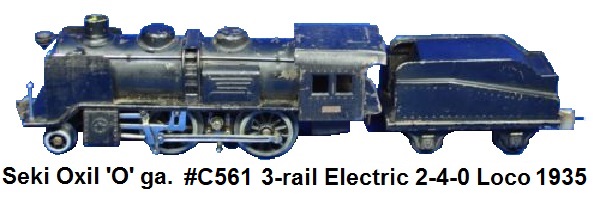 Seki was a model train manufacturer that got their start in 1934 prior to WWII in Tokyo, Japan. They manufactured electric
trains for export all over the world under the names Bryant, Oxil, Stronlite, Stalwart House, Standard Railway, and Maraklin.
Seki made tubular track, trains, signals, accessories, and other tinplate toys. Seki ceased operations during the war. What
happened after the war is uncertain, but many believe that they re-emerged as Sakai Seisakusho Ltd. as the trains manufactured
by that company were very similar to the pre-war trains made by Seki. During the post-war occupation period, many American
soldiers stationed in Japan purchased the low cost train sets manufactured by Sakai, and brought them home to their families
in the U.S. In the 1950's the company competed primarily with Marx in the U.S., offering some
interesting variants on Marx as well as low-end Lionel and American Flyer 'O' gauge train sets. Seki and
Sakai badge-engineered their trains for many different countries, for example the Stronlite brand was created specifically
for the UK market in the 1930's, Bryant was targeted at the European Continental market, the Maraklin brand was for the
Australian market, and the Stalwart House brand was used for HO train sets sold through Macy's Department Store in the United
States in the 1950's.
Seki was a model train manufacturer that got their start in 1934 prior to WWII in Tokyo, Japan. They manufactured electric
trains for export all over the world under the names Bryant, Oxil, Stronlite, Stalwart House, Standard Railway, and Maraklin.
Seki made tubular track, trains, signals, accessories, and other tinplate toys. Seki ceased operations during the war. What
happened after the war is uncertain, but many believe that they re-emerged as Sakai Seisakusho Ltd. as the trains manufactured
by that company were very similar to the pre-war trains made by Seki. During the post-war occupation period, many American
soldiers stationed in Japan purchased the low cost train sets manufactured by Sakai, and brought them home to their families
in the U.S. In the 1950's the company competed primarily with Marx in the U.S., offering some
interesting variants on Marx as well as low-end Lionel and American Flyer 'O' gauge train sets. Seki and
Sakai badge-engineered their trains for many different countries, for example the Stronlite brand was created specifically
for the UK market in the 1930's, Bryant was targeted at the European Continental market, the Maraklin brand was for the
Australian market, and the Stalwart House brand was used for HO train sets sold through Macy's Department Store in the United
States in the 1950's.
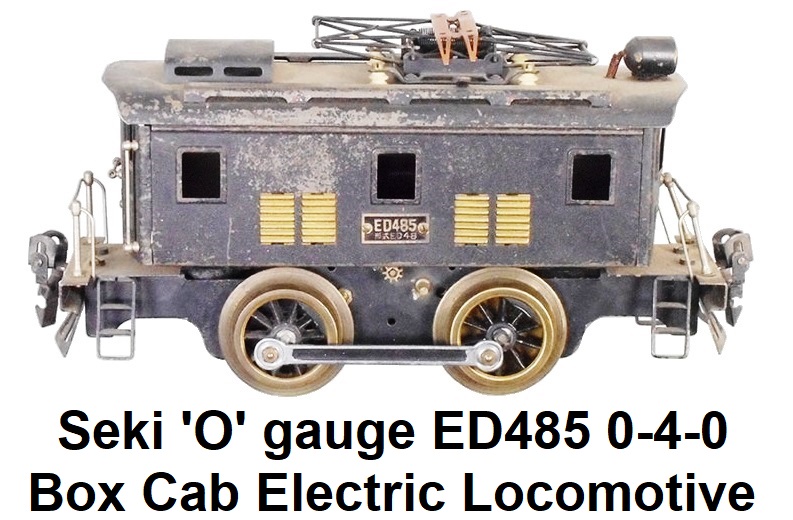
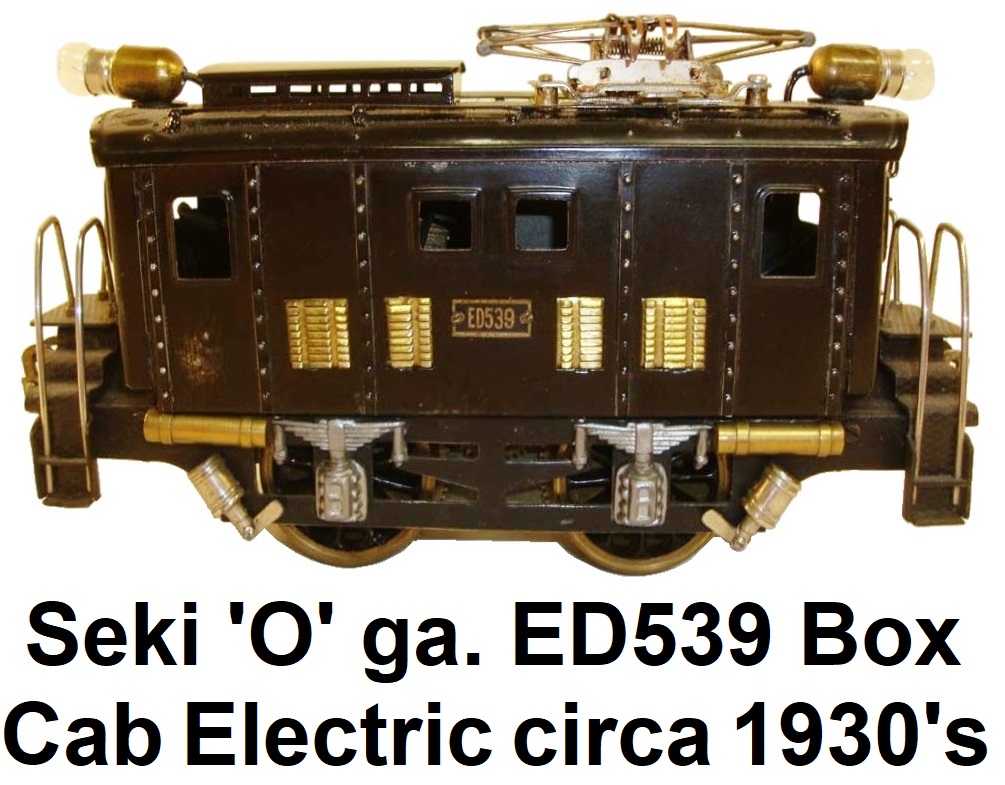 The pre-war Seki offerings were in 'O' gauge for 3-rail track and were representative models of prototypes that ran on the
railroads in Japan during this era, which consisted mostly of box cab electric types. A 1935 catalog from B. S. Sidline &
Company, of Kobe, Japan, pictures the Seki types ED53x and ED50x 0-4-0 box cab electrics that featured forward and reverse
movement and an operating headlight. Also pictured were a type ED16x 2-4-2 and a type ED54x 0-4-4-0 box cab electrics.
These Seki electric trains were produced using tinplate sections that were soldered together by hand. Locomotive details
included handrails, grab irons, ladders, brass plates, pantographs that could be raised and lowered on the electric models,
operating headlights, and reversing units. The Seki 'O' gauge ED16x 2-4-2 electric outline loco featured 2 pairs of driving
wheels, both of which were sparred as part of the wheel flange. This unique design was employed so that the wheel would
directly mesh with the drive gear powered by the electric motor. This type of sparred driver wheel was utilized on most of
the early Seki locomotives. Dual center-rail electrical pick-up shoes were fitted to the locos with a thick coil spring to
make excellent track connection. Many examples of the ED16x model have been found with Märklin type couplers from this era.
The pre-war Seki offerings were in 'O' gauge for 3-rail track and were representative models of prototypes that ran on the
railroads in Japan during this era, which consisted mostly of box cab electric types. A 1935 catalog from B. S. Sidline &
Company, of Kobe, Japan, pictures the Seki types ED53x and ED50x 0-4-0 box cab electrics that featured forward and reverse
movement and an operating headlight. Also pictured were a type ED16x 2-4-2 and a type ED54x 0-4-4-0 box cab electrics.
These Seki electric trains were produced using tinplate sections that were soldered together by hand. Locomotive details
included handrails, grab irons, ladders, brass plates, pantographs that could be raised and lowered on the electric models,
operating headlights, and reversing units. The Seki 'O' gauge ED16x 2-4-2 electric outline loco featured 2 pairs of driving
wheels, both of which were sparred as part of the wheel flange. This unique design was employed so that the wheel would
directly mesh with the drive gear powered by the electric motor. This type of sparred driver wheel was utilized on most of
the early Seki locomotives. Dual center-rail electrical pick-up shoes were fitted to the locos with a thick coil spring to
make excellent track connection. Many examples of the ED16x model have been found with Märklin type couplers from this era.

 Steam outline locomotives were all Pacific's and included a type C51x 2-6-0 with operating headlight and lacquered paint,
and the larger type C54x 2-6-0 with similar features. Another version of the 2-6-0 configuration was the streamlined
locomotive type c53x with tender. This unique locomotive was modeled after a popular streamliner that was operated in Japan
by the government railways in the 1930's and was commonly referred to as the 'Tsubame', which in Japanese means loved. It was
also referred to as the 'banjo' by Americans because it's profile somewhat resembles a banjo. The prototype, numbered 5343,
was the only one of the Japanese National Railway's 97 C53 class locos built to have shrouding. It was actually a narrow
gauge steam locomotive built sometime between 1928-31. A majority of Japan's railways are narrow gauge. The Seki steam
outline type models were all 6-coupled 2-6-0 wheel arrangments and were die-cast featuring full valve gear, piping detail,
and operating headlights. Only the 2nd and 3rd pair of drivers on the 6 coupled steam outline locomotives were spar-flanged
on one side and driven by the spar and flange gear. The 1st set of drivers were blind/unpowered. The reversing mechanism was
activated manually via a lever located in the engine cab.
Steam outline locomotives were all Pacific's and included a type C51x 2-6-0 with operating headlight and lacquered paint,
and the larger type C54x 2-6-0 with similar features. Another version of the 2-6-0 configuration was the streamlined
locomotive type c53x with tender. This unique locomotive was modeled after a popular streamliner that was operated in Japan
by the government railways in the 1930's and was commonly referred to as the 'Tsubame', which in Japanese means loved. It was
also referred to as the 'banjo' by Americans because it's profile somewhat resembles a banjo. The prototype, numbered 5343,
was the only one of the Japanese National Railway's 97 C53 class locos built to have shrouding. It was actually a narrow
gauge steam locomotive built sometime between 1928-31. A majority of Japan's railways are narrow gauge. The Seki steam
outline type models were all 6-coupled 2-6-0 wheel arrangments and were die-cast featuring full valve gear, piping detail,
and operating headlights. Only the 2nd and 3rd pair of drivers on the 6 coupled steam outline locomotives were spar-flanged
on one side and driven by the spar and flange gear. The 1st set of drivers were blind/unpowered. The reversing mechanism was
activated manually via a lever located in the engine cab.

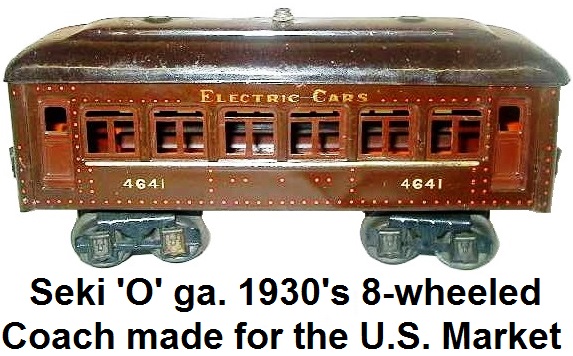
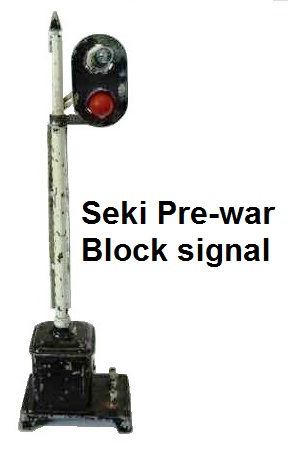 Seki also offered freight cars and passenger cars as well as a complete line of operating train-activated crossing signals,
semaphores, crossing gates, buildings, platforms and accessories. Seki 3-rail tubular track was heavy and solidly made, as
there were no shortages of steel in the pre-war period. Straight sections measured 290mm long, excluding the track pins. Each
sleeper/cross tie had two small rectangular 8mm punched holes for screwing the track to a layout or baseplate. An unusual
aspect of the Seki 3-rail track is that one outside rail is set about 1.5mm lower than the other 2 rails. This would be
helpful on curves, but the lowered outside rail is also found on their straight track.
Seki also offered freight cars and passenger cars as well as a complete line of operating train-activated crossing signals,
semaphores, crossing gates, buildings, platforms and accessories. Seki 3-rail tubular track was heavy and solidly made, as
there were no shortages of steel in the pre-war period. Straight sections measured 290mm long, excluding the track pins. Each
sleeper/cross tie had two small rectangular 8mm punched holes for screwing the track to a layout or baseplate. An unusual
aspect of the Seki 3-rail track is that one outside rail is set about 1.5mm lower than the other 2 rails. This would be
helpful on curves, but the lowered outside rail is also found on their straight track.
Some models of Seki production appear to have features copied from other manufacturer's trains. One item was a passenger
coach that resembled an early Lionel #610 coach with arch windows. The Seki version
was lithographed in green. The couplers utilized were close copies of Märklin's standard
European-type couplings. Other similarities have appeared in pre-World War II Seki tinplate, such as cars with older-style
Lionel-style tinplate trucks, Ives-type truck journals, and the Märklin-type couplers.
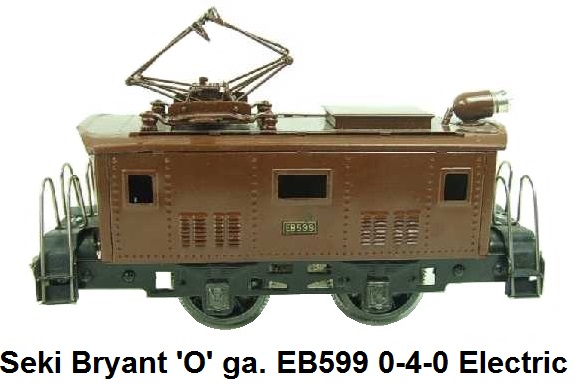
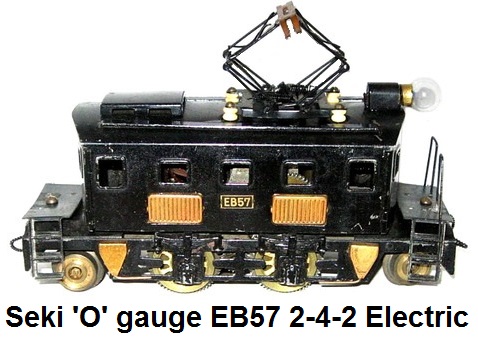
Seki trains were designed to run on 16 to 18 volts AC track power. To power the trains and accessories
Seki produced its own line of transformers. The top of the line model featured a faceplate made of marble and a series of
brass terminal taps. A plastic handled plated brass lever knob could be rotated to complete a circuit with whichever tap that
could provide the desired voltage. Marble was the most durable insulating material available before the advancement of
manufacturing technology for various synthetic resins and ceramic insulation. Each individual electrical tap on the
transformer was engraved using a punch to identify the voltage it provided. One line provided 0, 4, 6, 8, and 10 volts, while
a secondary line had 10, 11, 12, 14 and 16 volts. Accessories only required a constant current of 6 volts. Input voltage was
100 volts at 100 watts. A smaller transformer with a stamped steel case was also produced that had a 5-stage tap and produced
a total output of 40 watts at 5, 6, 7, 8, and 10 volts. The insulation plate in this transformer was made of fiber.
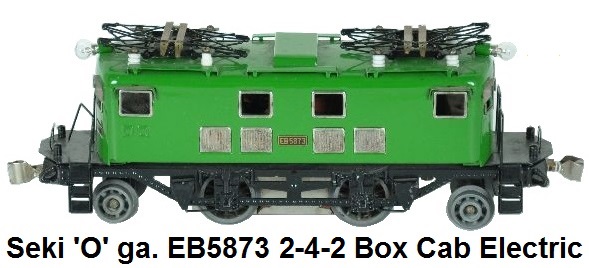

The first EB58 models were 2-4-2 configuration electrics, but these were later fitted with the 6-coupled
power unit, and the leading and trailing trucks were changed to 2 axels each. The early models were fitted with a manual
reverse and a crown uniaxial drive unit. Loco wheels were made of zinc, and as a result sparks emanated from the running
locomotive's wheels as they made contact with the rails. These early Seki models also featured more nuts and bolts
construction than their later releases. The detailed EB58 'O' gauge 4-6-4 Electric outline loco was featured in both a
passenger set with 3 cars and in a freight set that included an oil tanker and caboose.
Seki Trains Made For The British Market Under the Name Stronlite



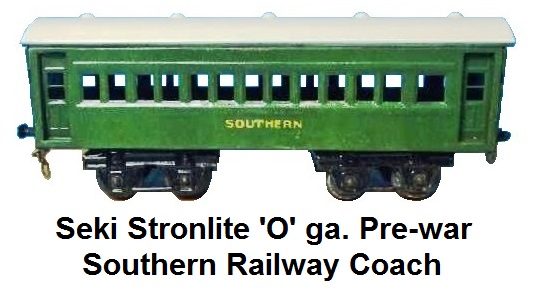
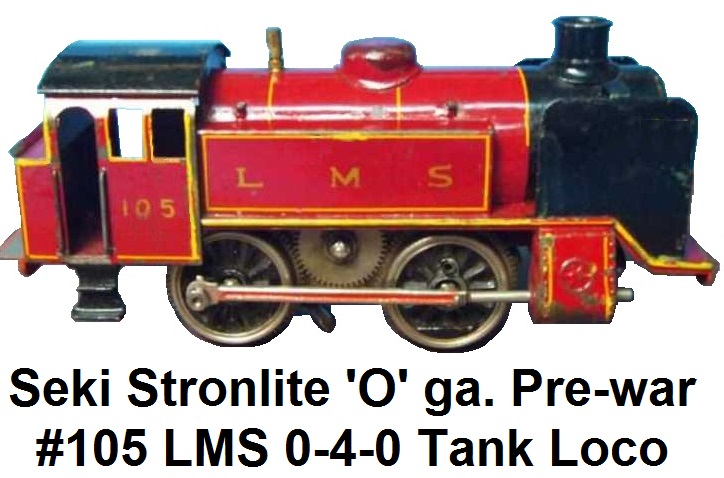 Starting in 1934 Seki supplied the UK market with a range of 'O' gauge products under the name 'Stronlite'. Evidently this
name was created by the London based Japanese importer Strong & Co. Initial offerings were the normal Seki
'O' gauge tinplate models manufactured for the home market in Japan. To appeal to a wider UK audience, models representing
the outlines common to the British Empire were subsequently developed. To accomodate this approach, Seki did what it normally
was known for - copying existing products from other manufacturers and undercutting the prices of the competitor's original
designs. Amongst the models offered was a set of printed tinplate copies of the Leed's LMS coaches and
the 4-4-2 loco that pulled the passenger set was a copy of the
Milbro 4-4-2 Tank locomotive.
Starting in 1934 Seki supplied the UK market with a range of 'O' gauge products under the name 'Stronlite'. Evidently this
name was created by the London based Japanese importer Strong & Co. Initial offerings were the normal Seki
'O' gauge tinplate models manufactured for the home market in Japan. To appeal to a wider UK audience, models representing
the outlines common to the British Empire were subsequently developed. To accomodate this approach, Seki did what it normally
was known for - copying existing products from other manufacturers and undercutting the prices of the competitor's original
designs. Amongst the models offered was a set of printed tinplate copies of the Leed's LMS coaches and
the 4-4-2 loco that pulled the passenger set was a copy of the
Milbro 4-4-2 Tank locomotive.
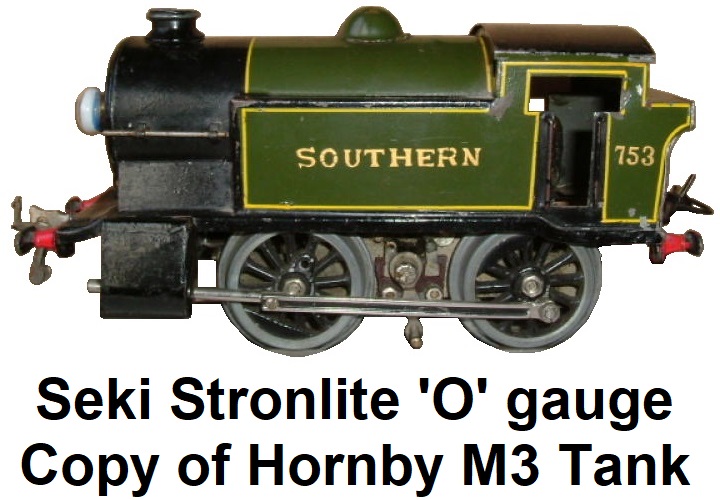 An 0-4-0 Tank locomotive
copy of the Leeds 0-4-0 Saddle Tank locos was also reproduced by Seki and sold in sets with either 2 painted tin passenger
cars or three open wagons. Sets were labeled for either the LNER, LMS, GWR or Southern liveries. Some sets were also sold
in the UK under the name Oxil, imported by the Allbright Electrical Co. Ltd. The Seki Tank loco copies are identifiable by a
heightened toolbox in the casting. This heightening was
done to accomodate fitting the larger Seki/Stronlite/Oxil electric motor into the chasis. Another distinguishing identifier is
the way the Seki models employed the drive gear as part of the wheel flanges, plus the wheels are also much more coarse scale
than those used on the Leeds locomotives. Other Leeds items copied by Seki/Stronlite included the LMC GW Siphon G wagon, LNER
Corridor Coach and LNER Corridor Brake Composite wagon. The Stronlite #4941 tipping wagon looks like a Hornby body mounted on
a Märklin chassis. The Oxil line featured a Tank loco appearing to be very similar to
the Hornby #1 Tank Loco. The outbreak of World War II brought production of Seki trains to a halt
in Japan when all manufacturing facilities were diverted to the war efforts.
An 0-4-0 Tank locomotive
copy of the Leeds 0-4-0 Saddle Tank locos was also reproduced by Seki and sold in sets with either 2 painted tin passenger
cars or three open wagons. Sets were labeled for either the LNER, LMS, GWR or Southern liveries. Some sets were also sold
in the UK under the name Oxil, imported by the Allbright Electrical Co. Ltd. The Seki Tank loco copies are identifiable by a
heightened toolbox in the casting. This heightening was
done to accomodate fitting the larger Seki/Stronlite/Oxil electric motor into the chasis. Another distinguishing identifier is
the way the Seki models employed the drive gear as part of the wheel flanges, plus the wheels are also much more coarse scale
than those used on the Leeds locomotives. Other Leeds items copied by Seki/Stronlite included the LMC GW Siphon G wagon, LNER
Corridor Coach and LNER Corridor Brake Composite wagon. The Stronlite #4941 tipping wagon looks like a Hornby body mounted on
a Märklin chassis. The Oxil line featured a Tank loco appearing to be very similar to
the Hornby #1 Tank Loco. The outbreak of World War II brought production of Seki trains to a halt
in Japan when all manufacturing facilities were diverted to the war efforts.


According to a 1988 interview with the company's original owner, also named Seki, the factories in Japan were bombed and
destroyed in 1945. Mr. Seki did not have the energy or resources to rebuild his manufacturing facilities. Former employees
then took over operations and made a fresh start utilizing remnants of pre-war production that could be recovered and newer
designs. In order to reconstruct the economy of Japan, many toy manufacturers and model makers produced products for export to
the U.S. after the war ended. The new company named Sakai Seisakusho Ltd. emerged in Japan around this time.

The Sakai 1948 catalog
pictured an electric outline locomotive in kit form, a set of MU cars, a 2-6-2 steam loco and tinplate passenger cars. The
early post-war era equipment was made of stamped and painted steel, similar to the pre-war offerings. Sakai trains were
manufactured utilizing tooling and designs that were almost identical to tools used to make the pre-war era Seki 'O' gauge
tinplate trains. The Sakai 8-wheel coaches from the post-war era are barely discernable from the 8-wheeled passenger coaches
from the pre-war period produced in the many British liveries and exported to England and the Netherlands in the late 1930's
under the brand names Stronlite, Bryant and Oxil. Eventually over time thinner sheet metal with lithography, and eventually
plastic materials found their way into the line. Surprisingly to many collectors, the detail and almost scale-like quality of
some of the Seki and Sakai electric outline locomotives produced in 'O' gauge made them very appealing to acquire. The EB58
reemerged in the post-war era and was one of these low cost but well designed locos. It was the electric outline model
offered in kit form. When Sakai re-entered the U.S. market after World War II, they began to produce some 'O' gauge trains
that were nearly identical copies of Marx designs. To add further insult, from 1946 to 1969 Sakai sometimes undercut Marx's
prices. In addition to producing tinplate and die-cast toys, the company also made tinplate boats with electric outboard
motors.
 One early post-war version of the Sakai
steam locomotive was a 2-6-0 die-cast bullet-nosed streamliner painted blue and called the A-4800. It was marketed under the
Standard Models brand, and packaged with a set of four blue painted tinplate passenger coaches, the same coaches that
were in the MU Interurban set. Seki/Sakai was one of the
first Japanese manufacturers to utilize the die-casting process in model train making. The die-cast Sakai #301 steam outline
locomotive in the 2-6-2 Prairie configuration looked similar to a Lionel #675. This loco became the flagship presence in the
Sakai line for many years. It is believed to have been the largest volume export item provided to the U.S. market, primarily
found in freight sets. It was sold mainly in department stores in Japan. Most of the ones made bore the #301. Early versions
were die-cast while later versions were plasti-cast using low density styrene resin. Both the
early and later tenders were made of tinplate. An automatic reversing device was standard in the Sakai 'O' gauge locos. The
Sakai automatic reversing device broke the field of the motor by driving a ratchet, similar to a
Lionel E-unit. However, the shift of the reversing device was only forward and reverse, unlike
Lionel's 3-position device with a neutral position in-between each direction shift. The 1st and 3rd drivers on the 6-coupled
Sakai power mechanism had flanged wheels, while the middle set of drivers were blind.
One early post-war version of the Sakai
steam locomotive was a 2-6-0 die-cast bullet-nosed streamliner painted blue and called the A-4800. It was marketed under the
Standard Models brand, and packaged with a set of four blue painted tinplate passenger coaches, the same coaches that
were in the MU Interurban set. Seki/Sakai was one of the
first Japanese manufacturers to utilize the die-casting process in model train making. The die-cast Sakai #301 steam outline
locomotive in the 2-6-2 Prairie configuration looked similar to a Lionel #675. This loco became the flagship presence in the
Sakai line for many years. It is believed to have been the largest volume export item provided to the U.S. market, primarily
found in freight sets. It was sold mainly in department stores in Japan. Most of the ones made bore the #301. Early versions
were die-cast while later versions were plasti-cast using low density styrene resin. Both the
early and later tenders were made of tinplate. An automatic reversing device was standard in the Sakai 'O' gauge locos. The
Sakai automatic reversing device broke the field of the motor by driving a ratchet, similar to a
Lionel E-unit. However, the shift of the reversing device was only forward and reverse, unlike
Lionel's 3-position device with a neutral position in-between each direction shift. The 1st and 3rd drivers on the 6-coupled
Sakai power mechanism had flanged wheels, while the middle set of drivers were blind.
While the die-cast Sakai #301 locomotive looked similar to a Lionel #675, it’s about 2½ inches too
short to be a 1:64 scale model of the Pennsylvania K5, though its height and width are about right, but it looked more
detailed and costly than anything Marx made in its price range. It also ran really well, as long as
the reverse unit was kept clean. Interestingly, there is a keystone shape embossed in the front boiler plate casting of the
Sakai locomotive. The pressed tinplate tender closely resembled the Marx tender it directly competed with, but
there were subtle differences. The most noticeable difference is that Marx’s tender was slightly wedge-shaped, while the Sakai
tender was squared off. Marx’s design disguised the differences across its product lines, and Sakai had no reason to do
that.
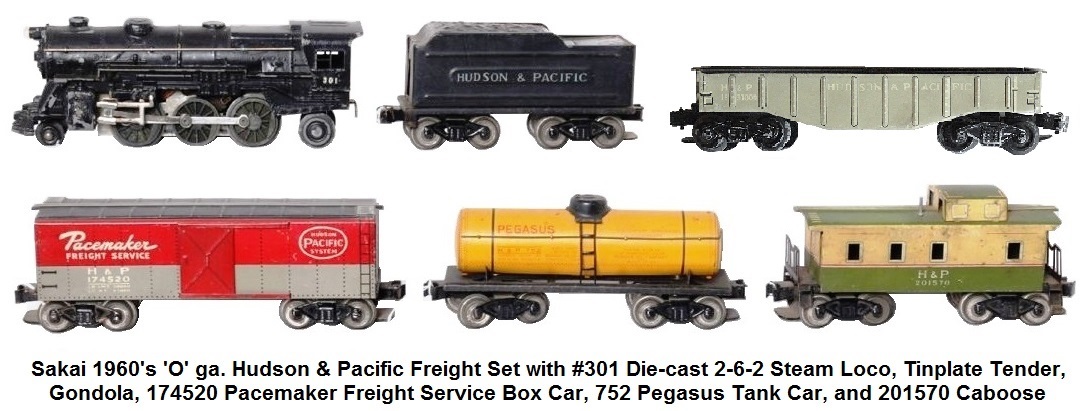
The #301 steam locomotive is most frequently found in a freight set that included a tender, an American-style box car
in NYC red over grey colors numbered 1744520, a grey gondola numbered 1530000, and a caboose numbered 201570. All cars were
lettered Hudson & Pacific, except for a yellow Pegasus tank car which was numbered 752. The freight cars were made of
lithographed sheet metal with stamped steel operating knuckle couplers. A considerable number of these sets were sold mainly
in department stores in Japan. Sets targeted at the American Market came in burnt-orange colored cardboard boxes bearing a
color illustration featuring the steam locomotive pulling a 3-car freight consist coming down the track approaching a
red based signal semaphore and in the background is an elevated steel girder trestle with a blue and white diesel locomotive.
The words 'Standard Rail Way Electric Toys' are emblazoned across the top of the image. There have been a few variations to
the #301 steam freight set discovered. Unlike U.S.-made trains that often had real brand names on them, Sakai used the name
of a fictional railroad. The earliest sets were marked Hutton & Pacific on the loco's tender and cars. They intended to label
them Hudson & Pacific. The mistake was caught quickly and the lettering was changed to Hudson & Pacific on later sets. Other
than the name change on the cars, the early and later sets were the same, both having stamped steel couplers. The Hutton &
Pacific version is very desirable to the Sakai collector, but these sets are extremely hard to find. A third version of this
set was the same as the second version, except it had die-cast trucks, couplers and wheels. This version is also very hard to
acquire.
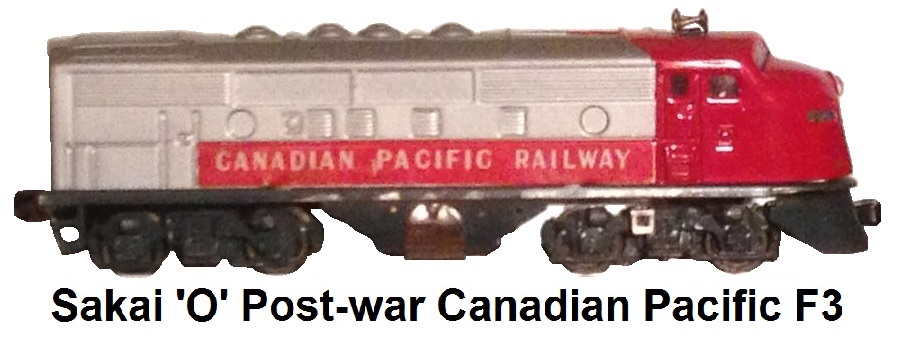 Sakai’s rolling stock was a near-exact copy of Marx’s 3/16 tin lithographed trains if they were placed on Lionel-sized trucks
with a Lionel-compatible knuckle coupler made of sheet metal. As mentioned, the later trains were labeled Hudson & Pacific on
the tender, box car, caboose, and gondola. The paint scheme and lettering closely resembled Marx’s New York Central-inspired
cars of the early post-war era. Sakai supplied a tank car lettered Pegasus, likely taking a cue from Mobil Oil, whose
trademark was a red Pegasus in flight. The paint scheme and overall layout closely resembled the yellow Shell-lettered tank
car that Marx sold in the early post-war era. In the post-war era Sakai also issued two 'O' gauge F-type diesel A unit sets
featuring the same freight cars included with the steam engine sets. One diesel set featured a Hudson & Pacific labeled loco
and the other a silver, red and grey loco lettered for the Canadian Pacific Railway. These diesels are quite rare today and
are highly sought after by collectors.
Sakai’s rolling stock was a near-exact copy of Marx’s 3/16 tin lithographed trains if they were placed on Lionel-sized trucks
with a Lionel-compatible knuckle coupler made of sheet metal. As mentioned, the later trains were labeled Hudson & Pacific on
the tender, box car, caboose, and gondola. The paint scheme and lettering closely resembled Marx’s New York Central-inspired
cars of the early post-war era. Sakai supplied a tank car lettered Pegasus, likely taking a cue from Mobil Oil, whose
trademark was a red Pegasus in flight. The paint scheme and overall layout closely resembled the yellow Shell-lettered tank
car that Marx sold in the early post-war era. In the post-war era Sakai also issued two 'O' gauge F-type diesel A unit sets
featuring the same freight cars included with the steam engine sets. One diesel set featured a Hudson & Pacific labeled loco
and the other a silver, red and grey loco lettered for the Canadian Pacific Railway. These diesels are quite rare today and
are highly sought after by collectors.
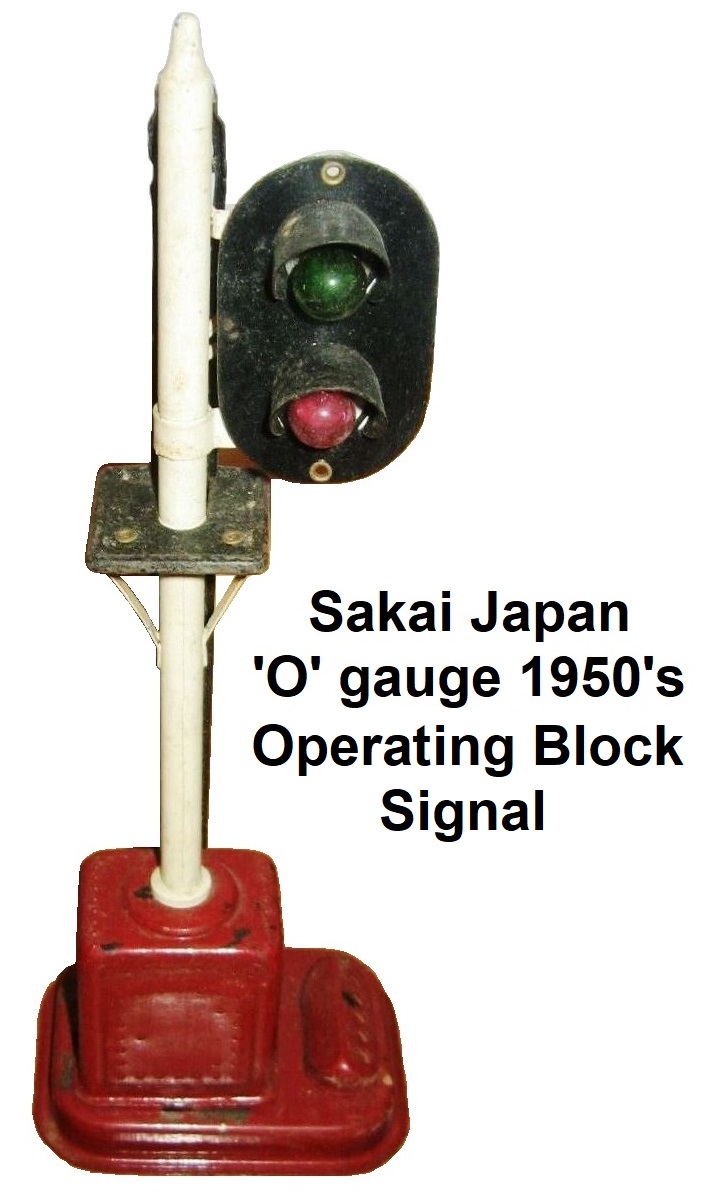
 Sakai made and sold O-27 gauge tubular steel track that looked just like contemporary Marx or Lionel track, except the ties
were located farther back from the ends and the cross ties were not painted or blackened. The post-war era Sakai 3-rail track
is made of a lighter metal than that used in the pre-war era Seki 3-rail track. On a straight section, the Sakai track has
223mm long rails, excluding the pins, and the two small circular holes for screwing the track to a layout are about 3mm
diameter punched in each sleeper/cross tie. It is believed that Sakai also OEM'd their track to other
North American train manufacturers for their inexpensive sets. Sakai’s switches have similar internal components to the Marx
#1590, although the controller is wired in a different way. A Marx or Atlas #56 controller can be
utilized with these switches if the original controller is missing, or if a conversion to make them non-derailing is desired.
The same instructions for Marx switches can be used to accomplish this conversion. Sakai’s switches are designed to operate
with either Marx or Lionel trains and track.
Sakai made and sold O-27 gauge tubular steel track that looked just like contemporary Marx or Lionel track, except the ties
were located farther back from the ends and the cross ties were not painted or blackened. The post-war era Sakai 3-rail track
is made of a lighter metal than that used in the pre-war era Seki 3-rail track. On a straight section, the Sakai track has
223mm long rails, excluding the pins, and the two small circular holes for screwing the track to a layout are about 3mm
diameter punched in each sleeper/cross tie. It is believed that Sakai also OEM'd their track to other
North American train manufacturers for their inexpensive sets. Sakai’s switches have similar internal components to the Marx
#1590, although the controller is wired in a different way. A Marx or Atlas #56 controller can be
utilized with these switches if the original controller is missing, or if a conversion to make them non-derailing is desired.
The same instructions for Marx switches can be used to accomplish this conversion. Sakai’s switches are designed to operate
with either Marx or Lionel trains and track.

Beginning in the 1950's Sakai also made HO gauge trains that operated on 14 volts AC utilizing 2-rail track. The first sets
featured a #H315 2-4-0 steam outline locomotive and tender pulling tinplate passenger cars.
The tinplate HO gauge passenger cars were very similar to the pre-war era 'O' gauge 8-wheel tinplate passenger cars.
They also produced an HO version of their 'O' gauge EB5873 4-6-4 box cab electric locomotive.

The first HO sets produced by Sakai featured cars that were made entirely of sheet metal. They were
marketed in sets in the United States under the name Standard Model Railway. The range included both freight and passenger
cars that appeared to be exact copies of the 'O' gauge tinplate freight and passenger cars that Sakai had produced in the
early post-war era. The wheel flanges on these HO locomotives were insulated on one side, and power was drawn from the track
using spring bolts. The flanges were at the same depth as other HO scale models from this period.
HO scale die-cast F-type diesels were also produced. Sometime later,
Sakai produced an American type HO 2-6-2 steam outline loco that was virtually a miniaturized version of their 'O' gauge
model, but die-cast instead of made of tinplate. The steam loco was initially labeled for the Hudson & Pacific fictious road,
but eventually it was marked for the Baltimore & Ohio, and given the #327. The HO 2-6-2 steam locomotive with
tender is also known to exist with Pennsylvania markings. These models always have black drive wheels and bear the number
#1017 on the side of the loco cab. The cab window frames are painted red and the surrounding sheet metal is white on the
sides.
The Sakai-produced Pennsylvania decorated 2-6-2 locomotive was also sold under the Champ brand name in
a set that included Varney and Mantua HO rolling stock. HO trains
became the primary product exported to the U.S. in the 1960's and 'O' gauge production became the focus of domestic sales in
Japan. The Sakai HO train locomotives were designed to pull 4 cars weighing a maximum of 17 ounces. This was the limit since
the engines were die-cast, and had die-cast trucks, which added a great deal of weight. Locos typically weighed around 20
ounces (1.4 pounds). The cast wheel frames and die-cast body did provide a greater deal of traction however, and the locos
were fitted with a substantial electric motor. The Sakai HO freight cars were equipped with scale-proportioned flanged
Bettendorf style trucks and wheel sets that were designed to run on true HO scale track, rather than the taller tinplate
track found in more toy-like plastic HO train sets of that era.
Sakai Produced HO Gauge Train Set Marketed Under the Name Stalwart House by Macy's Circa 1953

A second generation of
freight cars were made of tin printed/lithographed sheet metal. This made it possible to label the models very precisely.
The lithographed set consisted of the Hudson & Pacific F-type diesel locomotive, #752 Pegasus tank car, #7571-125
Hudson & pacific Pacemaker box car, #3620 Hudson & Pacific gondola and the #6025 Hudson & Pacific cupola caboose. These
sets were sold exclusively by Macy's Department Store under the Stalwart House brandname.
Sakai HO Gauge Trains Circa 1960's

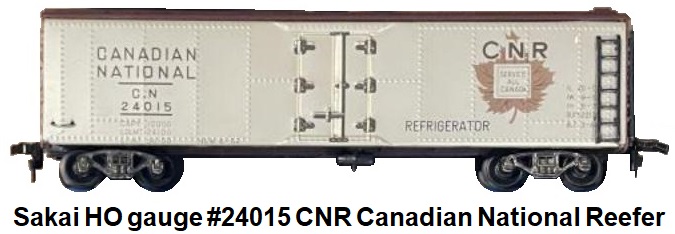 A later produced 3rd generation of Sakai HO gauge box cars and reefers were made of a combination of
tinplate sides with plastic roofs and floors. Handrails were metal, but decorative ladders were plastic. Later hoppers
consisted of detailed plastic shells with simulated coal loads mounted onto cast metal frames. Later cabooses were plastic
shells with die-cast frames and the handrails and ladders on the deck were pressed on steel plates. These Sakai HO box cars,
hoppers, and refrigerator cars were almost exact copies of HO freight cars produced during this period by the German
manufacturer Fleischmann. In addition to 2 locomotive models, more than a dozen versions
of these freight car models (4 reefer, 4 box cars, 4 hoppers and 1 caboose) and some accessories were also made during this
time.
A later produced 3rd generation of Sakai HO gauge box cars and reefers were made of a combination of
tinplate sides with plastic roofs and floors. Handrails were metal, but decorative ladders were plastic. Later hoppers
consisted of detailed plastic shells with simulated coal loads mounted onto cast metal frames. Later cabooses were plastic
shells with die-cast frames and the handrails and ladders on the deck were pressed on steel plates. These Sakai HO box cars,
hoppers, and refrigerator cars were almost exact copies of HO freight cars produced during this period by the German
manufacturer Fleischmann. In addition to 2 locomotive models, more than a dozen versions
of these freight car models (4 reefer, 4 box cars, 4 hoppers and 1 caboose) and some accessories were also made during this
time.

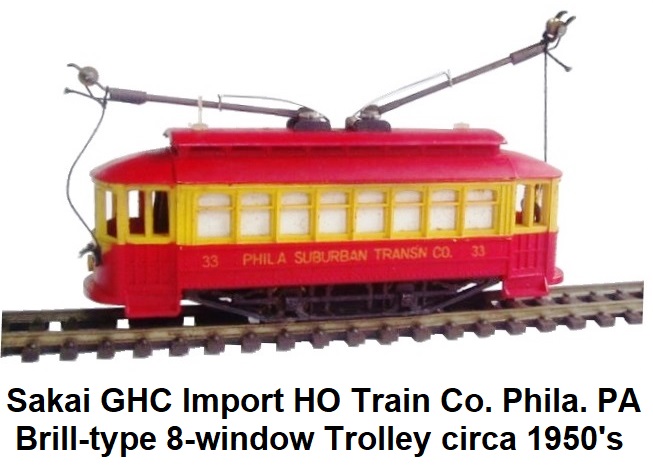 Sakai produced a ready-to-run HO scale 8-window plastic passenger trolley with dual overhead metal poles
that was sold in the U.S. for $4.95 under the General Hobbies Corp. (GHC) brand. The Brill-type trolley car was an accurate
representation of its prototype. It came in orange and yellow cardboard boxes that were marked with 'Manufactured for HO Train
Co. Phila. PA'. GHC was a company founded by Bernie Paul, known for importing toys and model trains produced in Japan starting
in the 1950's. Starting in 1953, an almost identical trolley began to appear in the catalogues of American HO train
manufacturer Mantua of Woodbury Heights, NJ, who marketed it under its 'Tyco' brand in the
United States. It is not known if Mantua acquired the trolley parts and plastic shells from Sakai. The Mantua version of the
trolley did not however include the realistic operating metal trolley poles, that were standard issue on the Sakai
manufactured version. Tyco versions of the trolley featured either a dummy plastic pole collector piece that
gave the car a semi-realistic appearance, or they came as street cars, that had no poles at all.
Sakai produced a ready-to-run HO scale 8-window plastic passenger trolley with dual overhead metal poles
that was sold in the U.S. for $4.95 under the General Hobbies Corp. (GHC) brand. The Brill-type trolley car was an accurate
representation of its prototype. It came in orange and yellow cardboard boxes that were marked with 'Manufactured for HO Train
Co. Phila. PA'. GHC was a company founded by Bernie Paul, known for importing toys and model trains produced in Japan starting
in the 1950's. Starting in 1953, an almost identical trolley began to appear in the catalogues of American HO train
manufacturer Mantua of Woodbury Heights, NJ, who marketed it under its 'Tyco' brand in the
United States. It is not known if Mantua acquired the trolley parts and plastic shells from Sakai. The Mantua version of the
trolley did not however include the realistic operating metal trolley poles, that were standard issue on the Sakai
manufactured version. Tyco versions of the trolley featured either a dummy plastic pole collector piece that
gave the car a semi-realistic appearance, or they came as street cars, that had no poles at all.
The Sakai HO track included in their ready-to-run train sets consisted of brass rails and
plastic sleepers. The track bears no markings to indicate the manufacturer. It is beleived that Sakai OEM'd their track to
other companies that also sold HO model train products and sets in the U.S. The Sakai track is similar to the products made
by Shinohara and Atlas during this period. A power pack that bore the Sakai logo was also included in
their sets. It was labeled as a Model 12 and featured 16 volt DC output for the trains and 16 volt AC output for accessories,
as well as a forward and reverse switch. Some HO freight sets were also marketed in the 1960's as a joint production by Bandai
and Sakai. These sets featured tinplate trains manufactured by Bandai bundled with 2-rail Sakai HO track with brass rails on
plastic ties and Sakai produced transformers that output 5 volts DC and AC. These sets came in cardboard boxes and bore the
Genuine Sakai logo as well as the Bandai Baby logo.
Baltimore & Ohio Battery Operated Set Freight Cars
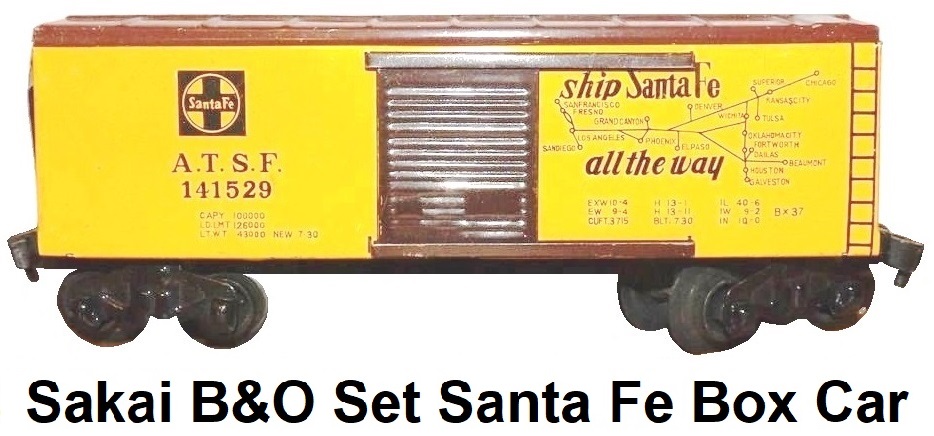
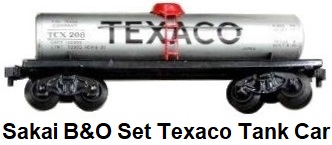
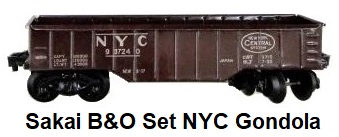
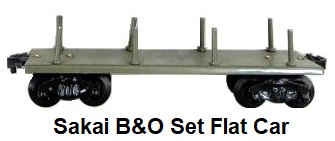
In later years Sakai produced train sets that utilized battery power to operate and were marketed under
the name 'Standard Gauge Large Model trains'. These trains are often times referred to as S gauge because the 2-rail tinplate
track was the same dimensions as S gauge track, and these trains could run on S gauge track produced by other manufacturers,
but the trains themselves were a smaller scale, closer to HO gauge. These trains were marketed as toys, not scale models, so
precise scale modeling was not a requirement. They featured all tin-plate lithographed construction for the diesel loco,
passenger cars and freight cars. These sets came in several different configurations, but were always headed by a diesel type
loco. Some freight sets had 4 cars, some had five and the top of the line set had seven. The passenger sets are normally found
with 3 passenger cars. The freight cars were fitted with 2 trucks or bogies, each with 4 flanged wheels, and included a silver
Texaco tank car with painted red dome numbered TCX208, a brown New York Central gondola numbered 937240, a gray flat car with
stakes, an ATSF Santa Fe sliding door box car in yellow and brown numbered 141529, an orange UP stock car numbered 19840, a
brown B&O 2-bay hopper numbered 3287 and a Baltimore & Ohio red cupola caboose numbered 19035. There was no actual Sakai
branding anywhere on the items in these sets, but they did say 'Made in Japan'. The sets featured F-type diesel locomotives,
primarily found with blue and gold painted Baltimore & Ohio RR livery. However, collectors have located versions of these sets
in a B&O 2-tone blue, a Santa Fe blue & yellow (Similar to the ATSF freight livery scheme but used for a passenger set) and a
rare Southern Pacific Daylight orange and red. The locomotives took 2 D-sized batteries that were inserted into a hatch on the
underside. The sets always came with a circle of the 2-rail S gauge tinplate track. It is believed that these HO/S gauge type
battery operated sets may have been collaboratively produced by Sakai with other manufacturers such as Daikin and Mego
Playthings.
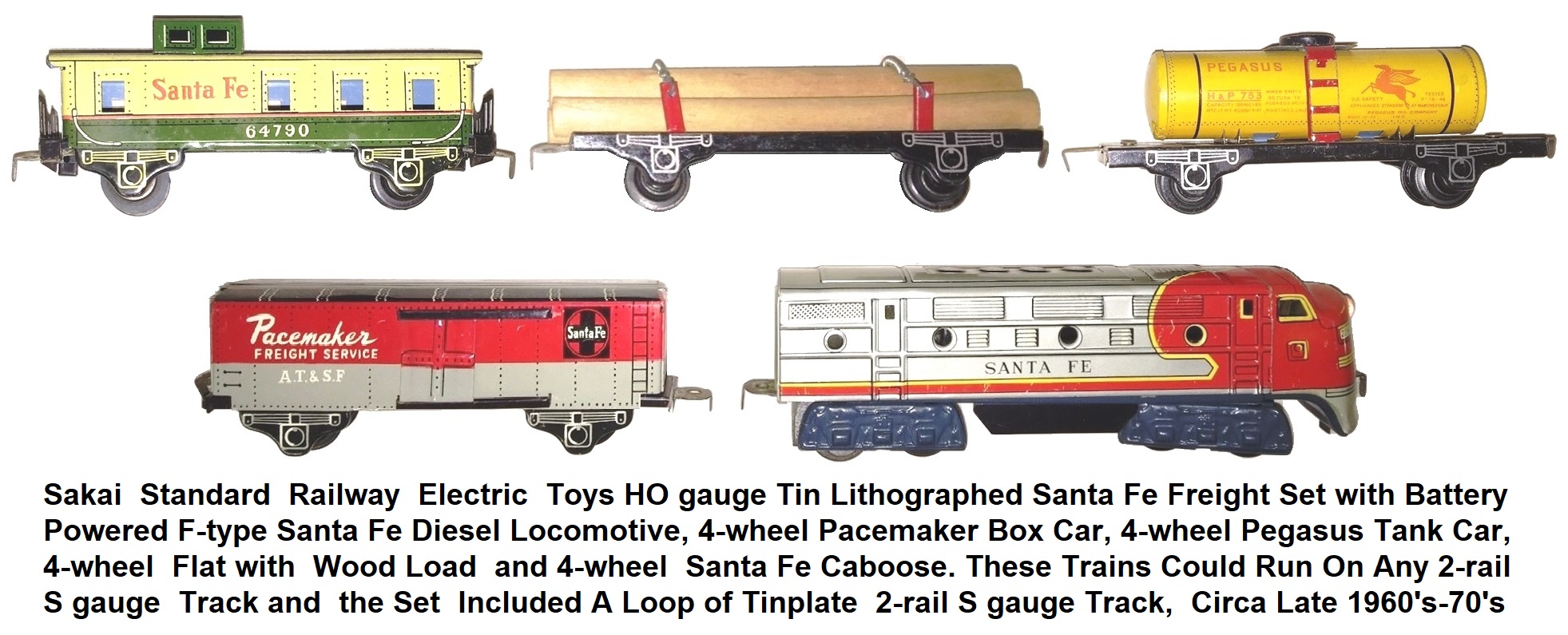
Another similar scale tin-litho
type battery powered freight set marketed under the Standard Railway Electric Toys branding has shown up that features a
Santa Fe #2356 F-type diesel loco adorning the famous war-bonnet paint scheme. The diesel is accompanied by cars that have 2
fixed axles, and only 4 flanged wheels on each car. The freight cars feature basic hook and eyelet-type couplers and consist
of an orange H&P #753 Pegasus single dome tank car, unumbered black flat car with lumber load, unumbered red and grey AT&SF
Pacemaker Freight Service sliding door box car and a green and cream colored #64790 Santa Fe cupola caboose. The loco
featured an on-off switch on the bottom. The items packaged in this set had no manufacturer's markings. The locomotive and
freight cars bore only the word 'JAPAN'. The cardboard set box did have a printed Sakai logo and was numbered 70906. The
set box lid bore an illustration depicting an F-3 diesel in red and white pulling a passenger consist with mountains in
the background.
By the 1970's model trains produced by Sakai disappeared from store shelves. Some collectors believe that
Japanese model train manufacturer Katsumi (KTM) may have taken over the tooling and designs.
The Sakai/Sakai Seisakusho/Sakai Seisakusho Ltd. Tokyo, Japan trademark was the company name "Sakai" placed within a diamond
shape with concave sides formed from what appears to be four swords. The nearly identical logo had the company name replaced
with the letters "SS". There is little collector interest in Sakai trains today, possibly because of difficulty identifying
the equipment and because the brand is much less widely known than its U.S. counterparts. However, the trains made by Seki in
the 1930's do have a following with a small group of collectors. Sakai trains are often referred to as Japanese Marx,
because of their close resemblence and similarities to the American made Marx trains. Exactly what became of Sakai is
unknown.
Back To Top of Page
